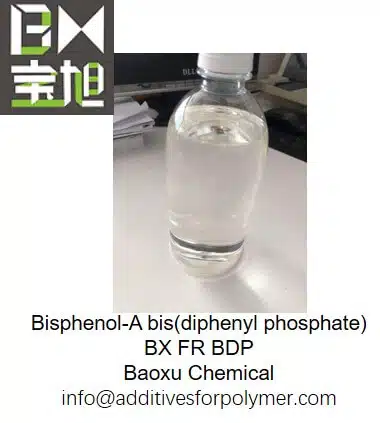Phosphorus Flame Retardants
Phosphorus Flame Retardants not only react with radicals like BFRs, but are also able to act in the condensed phase by enhancing char formation, yielding intumescence (foaming-up), or formation of inorganic glasses. PFRs are most commonly known as char formers, because during the burning process, they produce phosphoric acids, which, reacting with the substrate, produce a char that acts as a protection of the substrate itself. The most used PFRs are as the table below, their main area of application is in polyamides(PA), polyesters(PET/PBT), polyolefins, and polystyrene (PS) formulations, especially in electrical and electronic insulation components.
Baoxu Phosphorus flame retardants
| Item Name | CAS No. | Equivalent to | Form |
| BX FR TPP | 115-86-6 | Disflamoll TP | Liquid |
| BX FR BDP | 5945-33-5 | FP 600 | Liquid |
| BX FR BER | 68928-70-1 | Powder | |
| BX FR RDP | 57583-54-7 | CR-733S | Liquid |
| BX FR TCPP | 13674-84-5 | / | Liquid |
| BX FR APP | 68333-79-9 | 484 | Powder |
| BX FR 1230 | 225789-38-8 | OP1230/1240 | Powder |
| BX FR 930 | 225789-38-8 | OP930/935 | Powder |
| BX FR 950 | 37640-57-6 | OP950 | Powder |
Introduction of phosphorus flame retardants
TPP Is a Halogen Free Flame Retardant Plasticizer For Phenolic Resin, Vinyl Resin, And Rubber.
BDP is a Halogen Free Bisphosphate Flame Retardant Used For PC/ABS, PPO/HIPS, and Epoxy Resins. Replace FP 600.
RDP is a Halogen Free Phosphate Ester Flame Retardant Used For PC/ABS, PPO/HIPS.
TCPP Flame Retardant Is Used In the Production of Acetate Fiber, PVC, PU Foams, EVA, and Phenolic Materials. Replace PCF
APP Is An Ammonium Polyphosphate Flame Retardant Mainly Used In Plastic, Paint, Coating, Laminates, And Reinforced Materials. Replace 484, 486, C60, C30, and 3167
Melamine Polyphosphate Flame Retardant Is Mainly Used In PA And PBT, Especially PA6, and PA66.
BX FR 1230 is high performance organic phosphate flame retardant for nylon, PBT.
External links
Flame Retardant Wikipedia UL 94 Wikipedia
Flame Retardant Brochure Download

